“Hope for the best, but prepare to get filthy” probably sums up recent angling. I’d have loved a final crack at grayling or river pike on the fly before the season ended, but it has been mud soup everywhere. Such is angling in the early 21st century- not only do we get more concentrated rainfall and flooding than ever, but have mucked about with our countryside and rivers so much, they go “Willy Wonka” in no time.
Fancy ideals often thus have to give way to pragmatism- and that often means stillwaters rather than rivers and streams. Actually, this is a good time of year to chase species like carp, perch and trout- particularly if you can get onto the venues on weekdays when they are quieter. So, where do we start? I’ve had some wet but rewarding sport on the trout reservoirs. But first, to one of the greatest ever baits for flooded conditions.
Chopped worm fishing… and marginal gains!
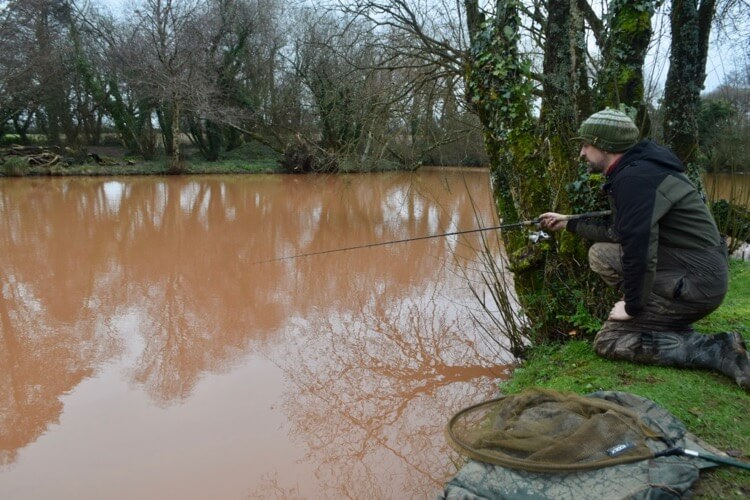
Every cloud has a silver lining- even those black ones that threaten a sequel to Noah’s Ark. Some obvious benefits, at least on stillwaters, are that full, murky margins tend to draw fish in really close. And one of my all-time favourite baits, worm, comes into its own.
On so many carp and mixed coarse fisheries, you can now catch within just a rodlength of the bank. The clarity, or lack of it, must help. I also strongly suspect that they find a lot of casualties like worms and slugs in wet conditions. The latter fall into my garden pond all the time, and the fish only leave those that are too big to eat! Similarly, when I drop in a few worm bits, they go crazy and literally clean the bottom.
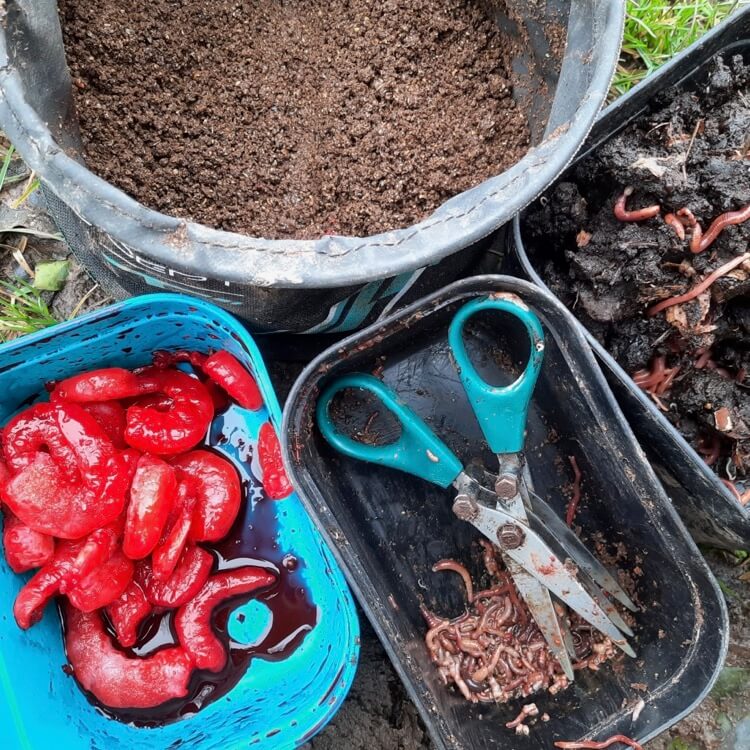
My muddy water menu- worms are a must!
Find any quiet fishery with deep margins, grab a load of worms and you are in business. I am not going to plonk you right in my favourite swim here- but suffice to say that there are lots of suitable fisheries in Devon and Somerset: Spires Lakes, Viaduct Fishery and Goodiford Mill are three that all have good depth and cover close to the bank- and all three regularly produce big perch and double figure carp.
A great example was this solid common of over 15lbs, caught just inches from the bank in horrid conditions. There really isn’t any need to grab three rods and cast miles on so many of our smaller lakes. Give me mobility and some worms, every time. Especially on venues peppered with boilies!
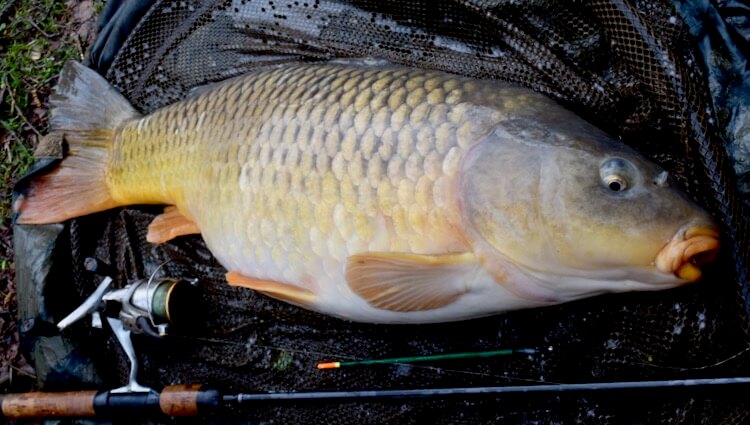
Another reason to thank those rain clouds, even when you get soaked, is that fisheries are more peaceful. This won’t be the case in a month or so when it’s picnic weather. Best get going while you can, therefore, and rove with just one rod and some bits between swims. Because I like this approach, I have to say I am not a big fan of booking apps like “Catch”- and where possible, I will still pay the fishery direct (which is also cheaper). After all, who wants to limit themself to one swim, let alone pick it before they have even had a walkabout on the venue?
More about my muddy weather adventures and tactics to come the Angling Times shortly – but suffice to say, if you travel light and feed at least three swims with a handful of worm and groundbait, you can have a ball while fisheries remain quiet. I tend to tackle up with sensitive float gear, 6lb line (or 8lb on a specimen lake) and simply hop between spots.
I have all the worms I could ever need from my compost heap- there are literally tens of thousands- but I would always take two other things: a pair of triple-bladed worm scissors, to mince the feed into a really potent mess, along with a few lobworms, just in case small fish keep beating the bigger mouths to the hook. Not that you’ll always need them. This chubby chap took two redworms on a barbless 12- an excellent, lively offering on a cold, muddy day.
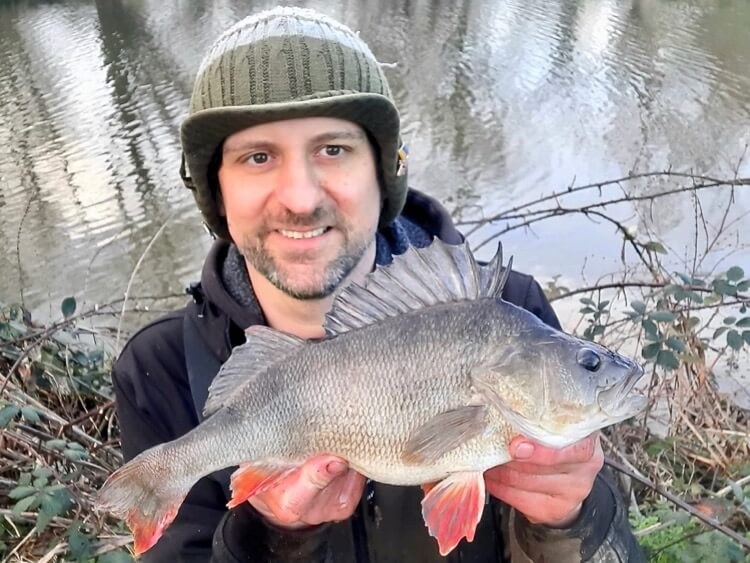
A great result- until I got home and looked at the horrendous state of my car boot, kit and clothing! Hopefully by the time you read this, things will be settling- and I can think about breaking out the fly rod again for coarse fish. For now, though, life is too short to be a one-method snob or “method martyr”!
Talking of which, I’ve been having some decent pike through the filth by swapping the lure and fly tactics for oily deadbaits fished over stinky groundbait. These fish can take a little more dedication these days with so much pressure on them, but it’s worth being patient- and this often means tweaking your approach or staying on a little. Another good tip is to stay off social media- or at least be really discrete with sharing and backgrounds. It might sound fussy, but some of the pike I’ve had this winter from obvious locations have been in really poor condition- and they don’t need any signposting!
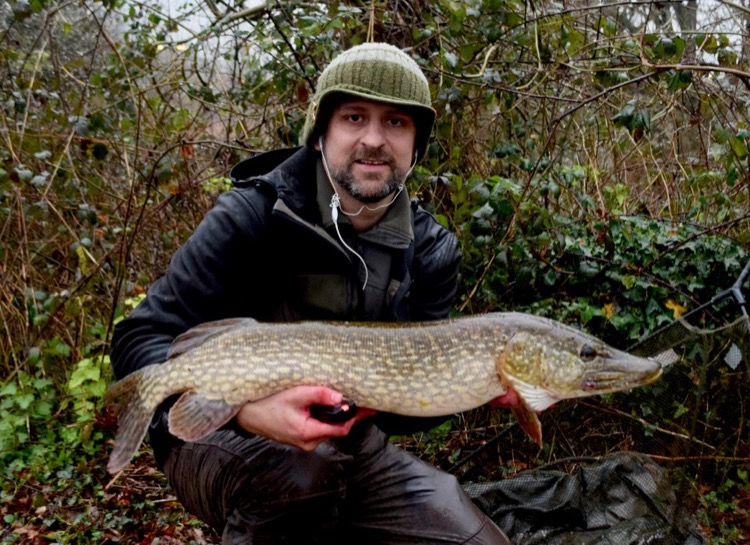
Trout fly fishing on Burrator and Hawkridge
Back on the theme of wet weather, our Devon and Somerset trout reservoirs offer some superb fishing this time of year. Just as well, because the rivers will need some time to fine down. I was hoping to hit the Usk this week, where the river fly fishing season for Wales tends to start earlier (on the 3rd March for many rivers- but always check your venue!). Fat chance of that with all the rain!

And so, on to plan B. On the Southern side of Dartmoor, near Plymouth and Tavistock, Burrator Reservoir has been a favourite for the past few seasons. It’s fantastically scenic and moody- even on a day of brutal weather. At various stages we couldn’t see halfway across the lake, let alone the far shore! It also responds to various tactics. Pulling lures can be fun, but even the more recently stocked trout don’t take long to get going on buzzers, which is such a lovely way to fish.
I had a welcome day off with Ben Garnett on this occasion- who is getting a real taste for fishing classic materials like cane and glass in his fly fishing. Each to their own I guess. I must say the feel of both are lovely for making modest fish feel bigger. It’s just that I wouldn’t want to be without my carbon 7 weight for hitting bigger distances in a crosswind.
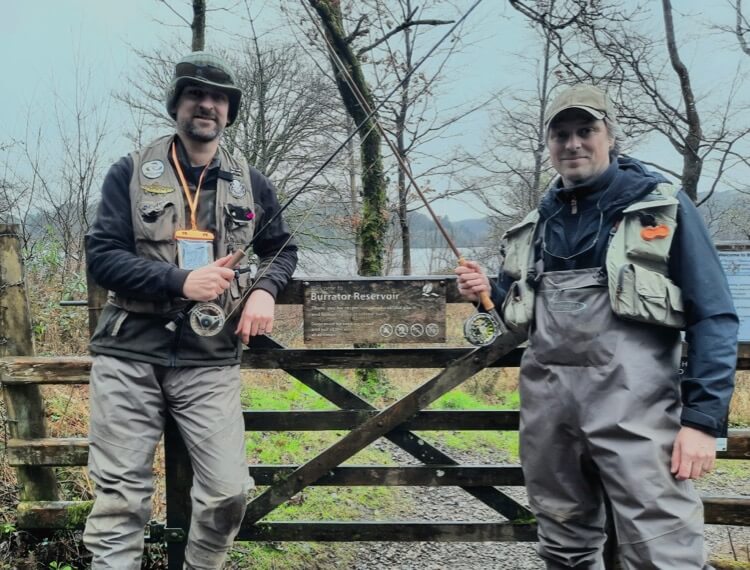
It was a topsy-turvy day. I got well beaten in the morning – partly my own silly fault for not packing a sinking line, because while I had no bites at all from Pig Trough bank and Longstone Point, Ben went two-nil up on the glass, using a sparkly damsel thingy to tame a good rainbow and a 10″ brown.

The moral here is always have a plan B and C. And if you didn’t bring that key item (a fast sink line in this case), be prepared to improvise! By tying on a leadhead and pinching a sink tip from big brother, I finally got off the mark with an unexpected brownie. Well, more of a silverie, to be precise. These wild fish are a bit special- and I tend to photograph them wet and very briefly, if at all.
Actually, this fish has stirred some debate! Could it in actual fact be a sea trout or even a salmon kelt? Burrator might be a manmade reservoir, but it is stream-fed (albeit by quite tiny streams), while I’ve also heard that it does produce the odd silvery fish, perhaps a remnant of the natural sea trout population of the area- which was only dammed quite recently, in the grand scheme of things. Regardless, what a fine looking fish- just look at the tail on it!
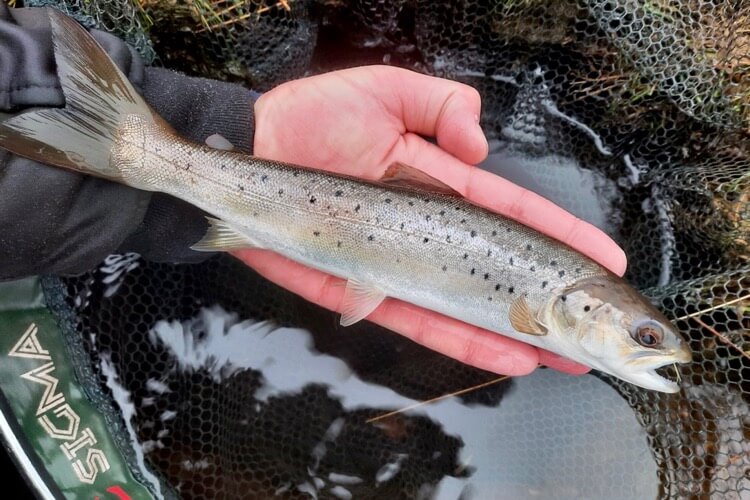
What a difference a few hours were to make. By early afternoon, we were both cold and wet and considering an early finish. In fact, my main entertainment till then was a really bold, white goose who decided we were life buddies after I’d given him some sandwich crust. He was a perfect-looking character, too, who could have come straight out of one of Julia Garnett’s storybooks. At this stage, we needed cheering up because even with decent coats and waders, we were soggy and cold.
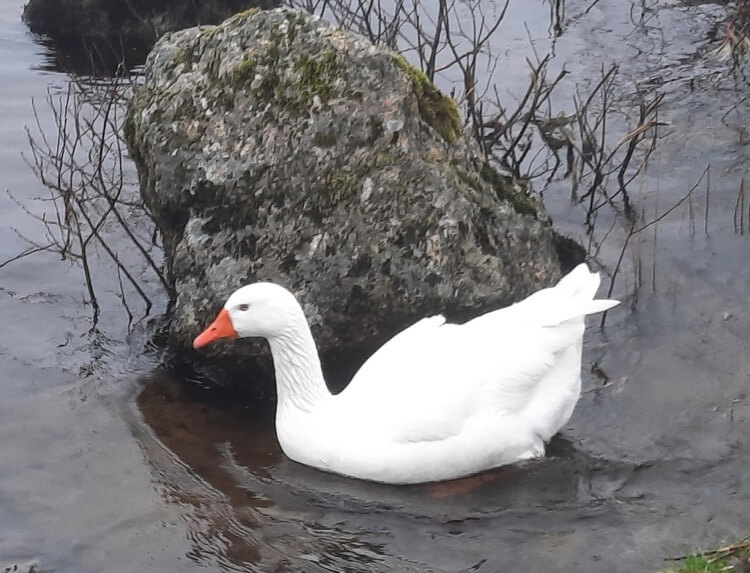
The hatch we wanted was still to come, though, as one or two early buzzers then became a mini blizzard. Presentation also got easier as we moved out of the harshest winds. At last- there were some moving fish! I nipped off the leadhead and set up a 12ft+ fluorocarbon leader with a spider on the point and a small buzzer on the dropper- and never looked back.
Another small brown arrived first, before I had a hattrick of rainbows- and the best fly was either a Green Flash or Black Hen Spider (you can see the exact patterns and tyings on my recent Turrall Flies blog HERE). I do love a soft-hackle, and small versions are great for buzzer hatches. The best of all the takes was a fish that did a proper bonefish impression at the surface, fins rippling right through the surface, before my leader pulled tight!
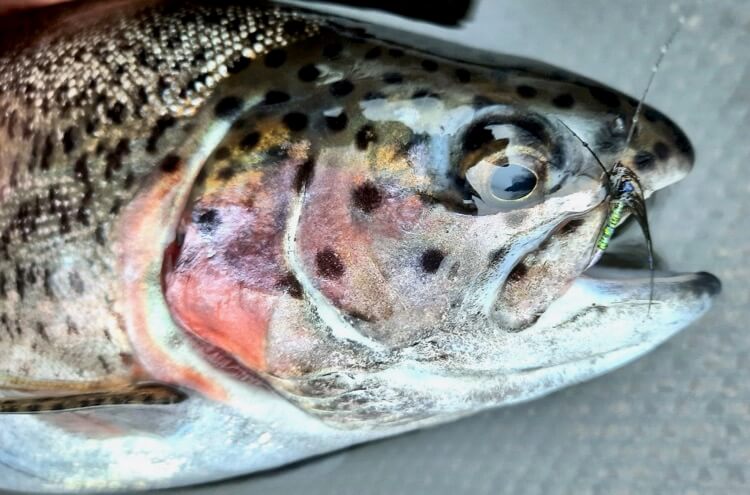
Less soggy altogether was a guiding mission on Hawkridge, which has been on sparkling form. My last guest made short work of learning how to cast a fly- before quickly managing to hook their first-ever trout. While things slowed down a bit in the afternoon, there were trout moving everywhere and it was only a matter of time before more bites arrived. The fish on this lake are big – and they seemed to like a black or green lure best. Don’t even think about tackling up with leaders less than 6lb breaking strain!

All of the above are well worth a visit as the weather (hopefully!) improves. Should you fancy some tuition for the day- whether that means classic float fishing or learning how to fly fish here in the South West, check out my guiding page.
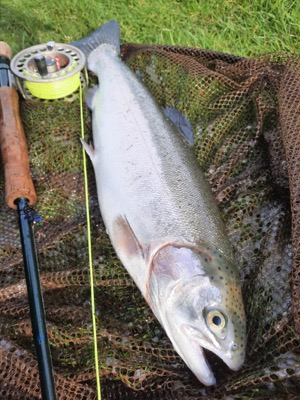
That’s about all for now, but until I post again do keep an eye on Angling Times! My usual column has all sorts of misadventures and talking points, along with lots of interesting news and features- to name just one highlight to come, I’ve just had the pleasure and honour of interviewing legendary Barnsley Blacks and England manager Dick Clegg OBE!


